Role of Nitrogen and Yttrium Contents in Manufacturing (Cr, Y)Nx Film Nanostructures
Abstract
:1. Introduction
2. Materials and Methods
2.1. Coating Deposition Process
2.2. Coating Characterization
3. Results and Discussion
4. Conclusions
- The thickness and deposition rate increase as the nitrogen flow rate increases, consequent to the rise in HiPIMS peak voltages applied to the Cr-Y target.
- The addition of 2 at.% Y increases the hardness of the fcc-CrN phase by almost 30% due to considerable refinement of the film architecture.
- Phase formation at low nitrogen flux 10 to 30 sccm has a microstructure formed by fcc-CrN and hexagonal Cr2N; at higher nitrogen fluxes, there is only fcc-CrN formation.
- The best mechanical and tribological performance was observed for the coating fabricated at a nitrogen flow rate of 50 sccm, where maximum hardness and wear resistance were obtained.
Author Contributions
Funding
Institutional Review Board Statement
Informed Consent Statement
Data Availability Statement
Acknowledgments
Conflicts of Interest
References
- Mattox, D.M. Handbook of Physical Vapor Deposition (PVD) Processing; Cambridge University Press: Cambridge, UK, 2007; pp. 1–945. [Google Scholar] [CrossRef]
- Sarakinos, K.; Alami, J.; Konstantinidis, S. High Power Pulsed Magnetron Sputtering: A Review on Scientific and Engineering State of the Art. Surf. Coat. Technol. 2010, 204, 1661–1684. [Google Scholar] [CrossRef]
- Klink, -D.; Aleksic, R.; Mazaheri, D.; Münz, W.-D.; Klink, R.; Aleksic, D.; Mazaheri, M. HIPIMS/UBM PVD Coating Equipment Designed to Coat Universal Sized Broaches. Coatings 2022, 12, 300. [Google Scholar] [CrossRef]
- Ohring, M. Deposition and Structure. In Materials Science of Thin Films; Academic Press: Cambridge, MA, USA, 2001. [Google Scholar]
- Kouznetsov, V.; MacÁk, K.; Schneider, J.M.; Helmersson, U.; Petrov, I. A Novel Pulsed Magnetron Sputter Technique Utilizing Very High Target Power Densities. Surf. Coat. Technol. 1999, 122, 290–293. [Google Scholar] [CrossRef]
- Greczynski, G.; Jensen, J.; Böhlmark, J.; Hultman, L. Microstructure Control of CrNx Films during High Power Impulse Magnetron Sputtering. Surf. Coat. Technol. 2010, 205, 118–130. [Google Scholar] [CrossRef] [Green Version]
- Garzon-Fontecha, A.; Castillo, H.A.; Restrepo-Parra, E.; De La Cruz, W. The Role of the Nitrogen Flow Rate on the Transport Properties of CrN Thin Films Produced by DC Magnetron Sputtering. Surf. Coat. Technol. 2018, 334, 98–104. [Google Scholar] [CrossRef]
- Zhang, D.; Zuo, X.; Wang, Z.; Li, H.; Chen, R.; Wang, A.; Ke, P. Comparative Study on Protective Properties of CrN Coatings on the ABS Substrate by DCMS and HiPIMS Techniques. Surf. Coat. Technol. 2020, 394, 125890. [Google Scholar] [CrossRef]
- Avila, P.R.T.; da Silva, E.P.; Rodrigues, A.M.; Aristizabal, K.; Pineda, F.; Coelho, R.S.; Garcia, J.L.; Soldera, F.; Walczak, M.; Pinto, H.C. On Manufacturing Multilayer-like Nanostructures Using Misorientation Gradients in PVD Films. Sci. Rep. 2019, 9, 15898. [Google Scholar] [CrossRef] [Green Version]
- Brooks, J.A.; Williams, J.C.; Thompson, A.W. Microstructural Origin of the Skeletal Ferrite Morphology of Austenitic Stainless Steel Welds. Metall. Trans. A 1983, 14, 1271–1281. [Google Scholar] [CrossRef]
- Banko, L.; Lysogorskiy, Y.; Grochla, D.; Naujoks, D.; Drautz, R.; Ludwig, A. Predicting Structure Zone Diagrams for Thin Film Synthesis by Generative Machine Learning. Commun. Mater. 2020, 1, 15. [Google Scholar] [CrossRef] [Green Version]
- Thornton, J.A. Influence of Apparatus Geometry and Deposition Conditions on the Structure and Topography of Thick Sputtered Coatings. J. Vac. Sci. Technol. 1974, 11, 666–670. [Google Scholar] [CrossRef]
- Purandare, Y.P.; Ehiasarian, A.P.; Stack, M.M.; Hovsepian, P.E. CrN/NbN Coatings Deposited by HIPIMS: A Preliminary Study of Erosion–Corrosion Performance. Surf. Coat. Technol. 2010, 204, 1158–1162. [Google Scholar] [CrossRef] [Green Version]
- Scheerer, H.; Berger, C. Wear Mechanisms of (Cr,Al,Y)N PVD Coatings at Elevated Temperatures. Plasma Process. Polym. 2009, 6, S157–S161. [Google Scholar] [CrossRef]
- Domínguez-Meister, S.; El Mrabet, S.; Escobar-Galindo, R.; Mariscal, A.; Jiménez De Haro, M.C.; Justo, A.; Brizuela, M.; Rojas, T.C.; Sánchez-López, J.C. Role of Y in the Oxidation Resistance of CrAlYN Coatings. Appl. Surf. Sci. 2015, 353, 504–511. [Google Scholar] [CrossRef] [Green Version]
- Jiang, X.; Yang, F.-C.; Chen, W.-C.; Lee, J.-W.; Chang, C.-L. Effect of Nitrogen-Argon Flow Ratio on the Microstructural and Mechanical Properties of AlSiN Thin Films Prepared by High Power Impulse Magnetron Sputtering. Surf. Coat. Technol. 2017, 320, 138–145. [Google Scholar] [CrossRef]
- Tang, J.-F.; Lin, C.-Y.; Yang, F.-C.; Chang, C.-L. Influence of Nitrogen Content and Bias Voltage on Residual Stress and the Tribological and Mechanical Properties of CrAlN Films. Coatings 2020, 10, 546. [Google Scholar] [CrossRef]
- Avila, P.R.T.; Apolinário, R.C.; Rodrigues, A.M.; Fernandes, J.V.; Menezes, R.R.; de Araújo Neves, G.; Pinto, H.C. On Improving Wear Resistance of Cr-Al-N Coatings Using Dynamic Glancing Angle DC Magnetron Sputtering. Nanomaterials 2021, 11, 2187. [Google Scholar] [CrossRef]
- Avila, P.R.T.; Rodrigues, A.M.; Guimarães, M.C.R.; Walczak, M.; Menezes, R.R.; de Araújo Neves, G.; Pinto, H.C. Nitrogen-Enriched Cr1−xAlxN Multilayer-Like Coatings Manufactured by Dynamic Glancing Angle Direct Current Magnetron Sputtering. Materials 2020, 13, 3650. [Google Scholar] [CrossRef]
- Guimaraes, M.C.R.; de Castilho, B.C.N.M.; de Souza Nossa, T.; Avila, P.R.T.; Cucatti, S.; Alvarez, F.; Garcia, J.L.; Pinto, H.C. On the Effect of Substrate Oscillation on CrN Coatings Deposited by HiPIMS and DcMS. Surf. Coat. Technol. 2018, 340, 112–120. [Google Scholar] [CrossRef]
- Guimarães, M.C.R.; De Castilhoa, B.C.N.M.; Cunha, C.; Correr, W.R.; Mordente, P.; Alvarez, F.; Pinto, H.C. On the Effect of Aluminum on the Microstructure and Mechanical Properties of CrN Coatings Deposited by HiPIMS. Mater. Res. 2018, 21, 20170848. [Google Scholar] [CrossRef]
- Mahato, P.; Singh, R.J.; Pathak, L.C.; Mishra, S.K. Effect of Nitrogen on Mechanical, Oxidation and Structural Behaviour of Ti–Si–B–C–N Nanocomposite Hard Coatings Deposited by DC Sputtering. Surf. Interface Anal. 2016, 48, 1080–1089. [Google Scholar] [CrossRef]
- Dulmaa, A.; Cougnon, F.G.; Dedoncker, R.; Depla, D. On the Grain Size-Thickness Correlation for Thin Films. Acta Mater. 2021, 212, 116896. [Google Scholar] [CrossRef]
- Fenker, M.; Balzer, M.; Kappl, H. Corrosion Protection with Hard Coatings on Steel: Past Approaches and Current Research Efforts. Surf. Coat. Technol. 2014, 257, 182–205. [Google Scholar] [CrossRef]
- Zhou, Z.; Xu, J.; Liu, Y.; Wei, C.; Zhang, H.; Wang, Q. Zn-Alloyed MAPbBr3 Crystals with Improved Thermoelectric and Photocatalytic Properties. Mater. Chem. Front. 2021, 5, 8319–8332. [Google Scholar] [CrossRef]
- Lin, S.; Li, Y.; Qian, J.; Lau, S.P. Emerging Opportunities for Black Phosphorus in Energy Applications. Mater. Today Energy 2019, 12, 1–25. [Google Scholar] [CrossRef]
- Oliver, W.C.; Pharr, G.M. An Improved Technique for Determining Hardness and Elastic Modulus Using Load and Displacement Sensing Indentation Experiments. J. Mater. Res. 1992, 7, 1564–1583. [Google Scholar] [CrossRef]
- Shan, L.; Wang, Y.; Li, J.; Chen, J. Effect of N2 Flow Rate on Microstructure and Mechanical Properties of PVD CrNx Coatings for Tribological Application in Seawater. Surf. Coat. Technol. 2014, 242, 74–82. [Google Scholar] [CrossRef]
- Neuville, S.; Matthews, A. A Perspective on the Optimisation of Hard Carbon and Related Coatings for Engineering Applications. Thin Solid Films 2007, 515, 6619–6653. [Google Scholar] [CrossRef]
- Vargas, M.; Castillo, H.A.; Restrepo-Parra, E.; De La Cruz, W. Stoichiometry Behavior of TaN, TaCN and TaC Thin Films Produced by Magnetron Sputtering. Appl. Surf. Sci. 2013, 279, 7–12. [Google Scholar] [CrossRef]
- Jimenez, M.J.M.; Antunes, V.G.; Zagonel, L.F.; Figueroa, C.A.; Wisnivesky, D.; Alvarez, F. Effect of the Period of the Substrate Oscillation in the Dynamic Glancing Angle Deposition Technique: A Columnar Periodic Nanostructure Formation. Surf. Coatings Technol. 2020, 383, 125237. [Google Scholar] [CrossRef]
- Paulitsch, J.; Schenkel, M.; Zufraß, T.; Mayrhofer, P.H.; Münz, W.D. Structure and Properties of High Power Impulse Magnetron Sputtering and DC Magnetron Sputtering CrN and TiN Films Deposited in an Industrial Scale Unit. Thin Solid Films 2010, 518, 5558–5564. [Google Scholar] [CrossRef]
- Lin, J.; Sproul, W.D.; Moore, J.J.; Lee, S.; Myers, S. High Rate Deposition of Thick CrN and Cr 2 N Coatings Using Modulated Pulse Power (MPP) Magnetron Sputtering Approved for Public Release. Surf. Coat. Technol. 2011, 205, 3226–3234. [Google Scholar] [CrossRef]
- Jimenez, M.J.M.; Antunes, V.; Cucatti, S.; Riul, A.; Zagonel, L.F.; Figueroa, C.A.; Wisnivesky, D.; Alvarez, F. Physical and Micro-Nano-Structure Properties of Chromium Nitride Coating Deposited by RF Sputtering Using Dynamic Glancing Angle Deposition. Surf. Coatings Technol. 2019, 372, 268–277. [Google Scholar] [CrossRef]
- Musil, J.; Kunc, F.; Zeman, H.; Poláková, H. Relationships between Hardness, Young‘s Modulus and Elastic Recovery in Hard Nanocomposite Coatings. Surf. Coat. Technol. 2002, 154, 304–313. [Google Scholar] [CrossRef]
- Wasekar, N.P.; Haridoss, P.; Seshadri, S.K.; Sundararajan, G. Sliding Wear Behavior of Nanocrystalline Nickel Coatings: Influence of Grain Size. Wear 2012, 296, 536–546. [Google Scholar] [CrossRef]
- Li, B.-S.; Wang, T.-G.; Ding, J.; Cai, Y.; Shi, J.; Zhang, X. Influence of N2/Ar Flow Ratio on Microstructure and Properties of the AlCrSiN Coatings Deposited by High-Power Impulse Magnetron Sputtering. Coatings 2017, 8, 3. [Google Scholar] [CrossRef] [Green Version]
- Warcholinski, B.; Gilewicz, A.; Kuznetsova, T.A.; Zubar, T.I.; Chizhik, S.A.; Abetkovskaia, S.O.; Lapitskaya, V.A. Mechanical Properties of Mo(C)N Coatings Deposited Using Cathodic Arc Evaporation. Surf. Coat. Technol. 2017, 319, 117–128. [Google Scholar] [CrossRef]
- Hurkmans, T.; Lewis, D.B.; Brooks, J.S.; Münz, W.-D. Chromium Nitride Coatings Grown by Unbalanced Magnetron (UBM) and Combined Arc/Unbalanced Magnetron (ABSTM) Deposition Techniques. Surf. Coat. Technol. 1996, 86–87, 192–199. [Google Scholar] [CrossRef]
- Van Essen, P.; Hoy, R.; Kamminga, J.-D.; Ehiasarian, A.P.; Janssen, G.C.A.M. Scratch Resistance and Wear of CrNx Coatings. Surf. Coat. Technol. 2006, 200, 3496–3502. [Google Scholar] [CrossRef]
- Živić, F.; Babić, M.; Mitrović, S.; Todorović, P. Interpretation of the Friction Coefficient during Reciprocating Sliding of Ti6Al4V Alloy against Al2O3. Tribol. Ind. 2011, 33, 36–42. [Google Scholar]
- Tsui, T.Y.; Pharr, G.M.; Oliver, W.C.; Bhatia, C.S.; White, R.L.; Anders, S.; Anders, A.; Brown, I.G. Nanoindentation and Nanoscratching of Hard Carbon Coatings for Magnetic Disks. MRS Proc. 1995, 383, 447–452. [Google Scholar] [CrossRef] [Green Version]

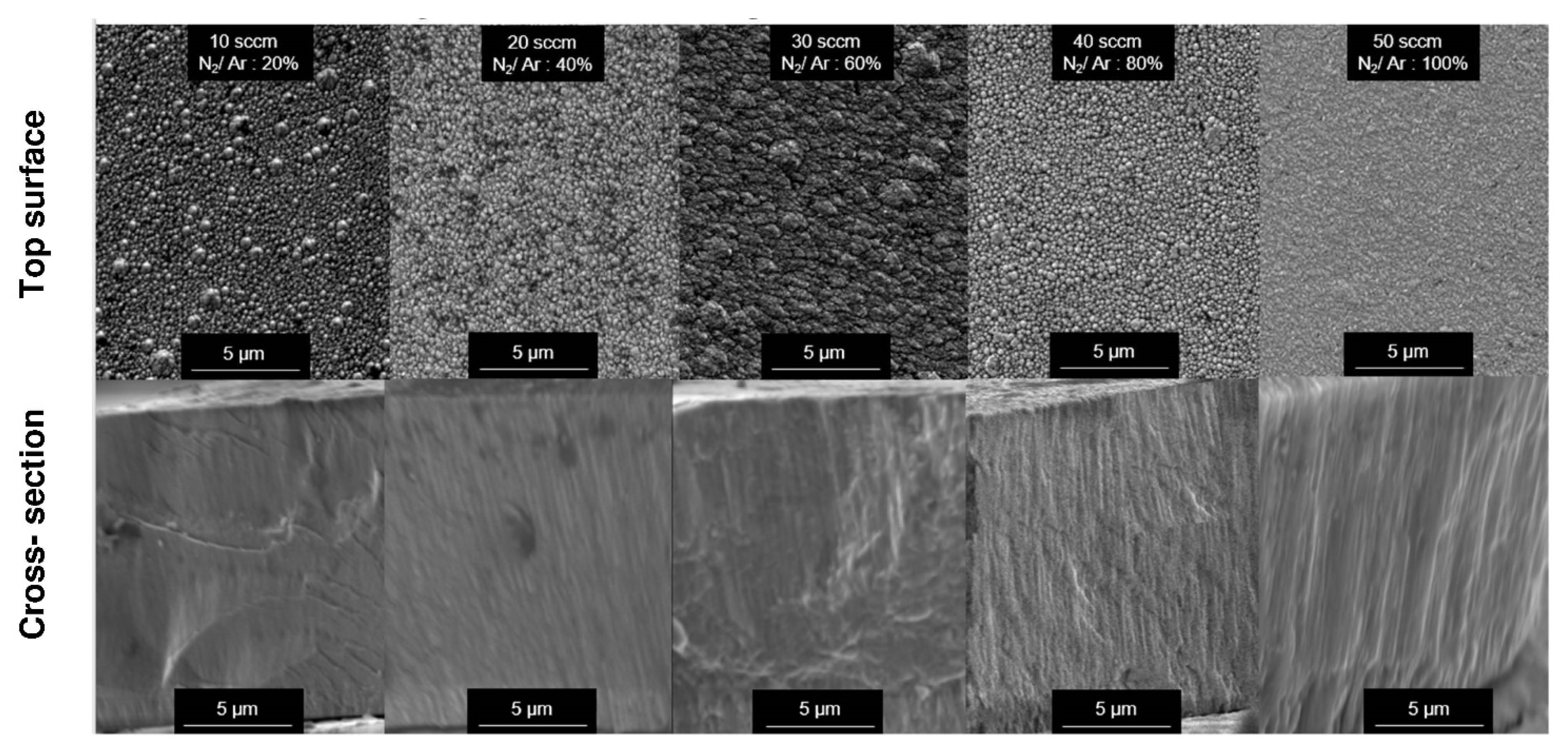

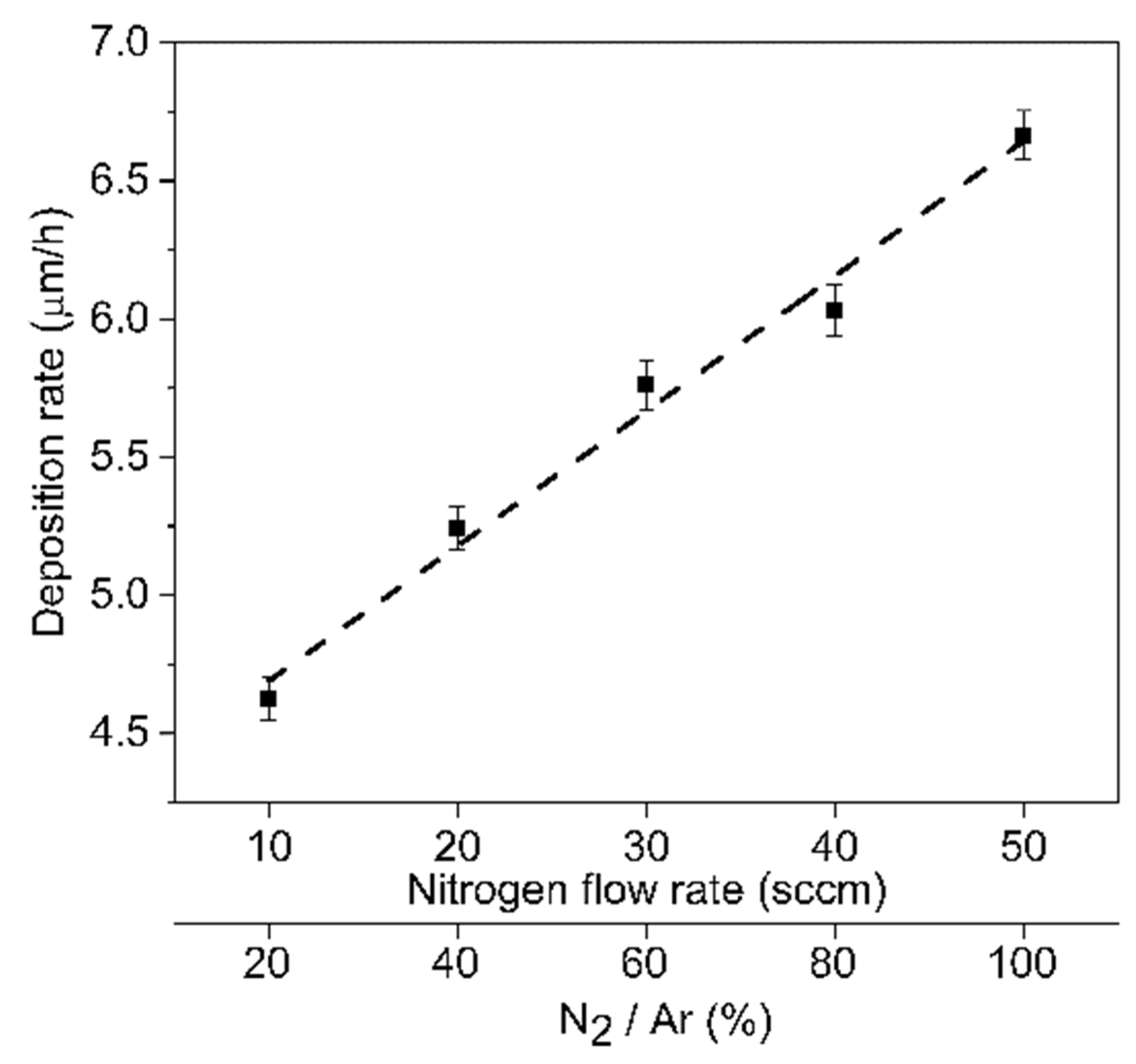
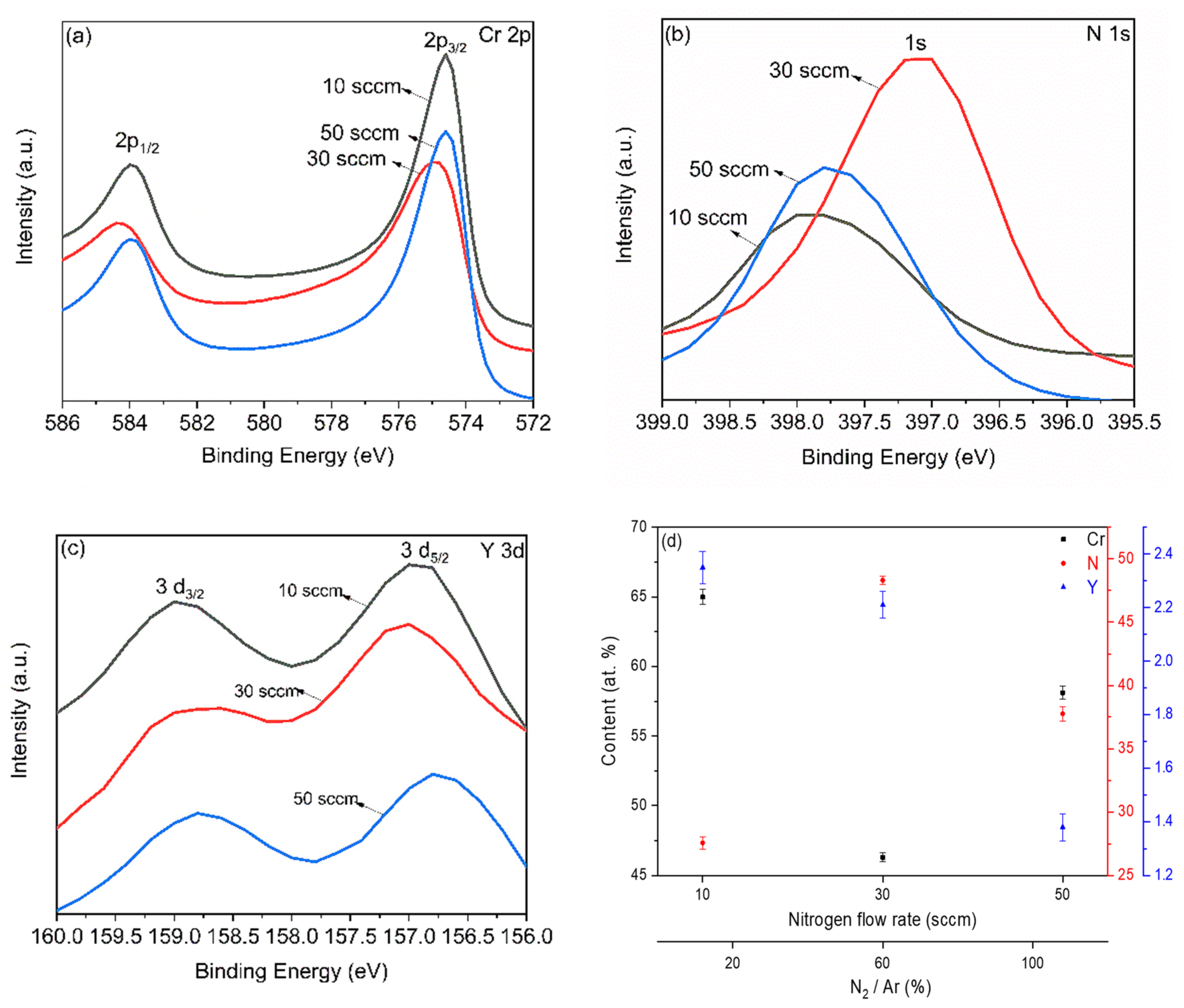
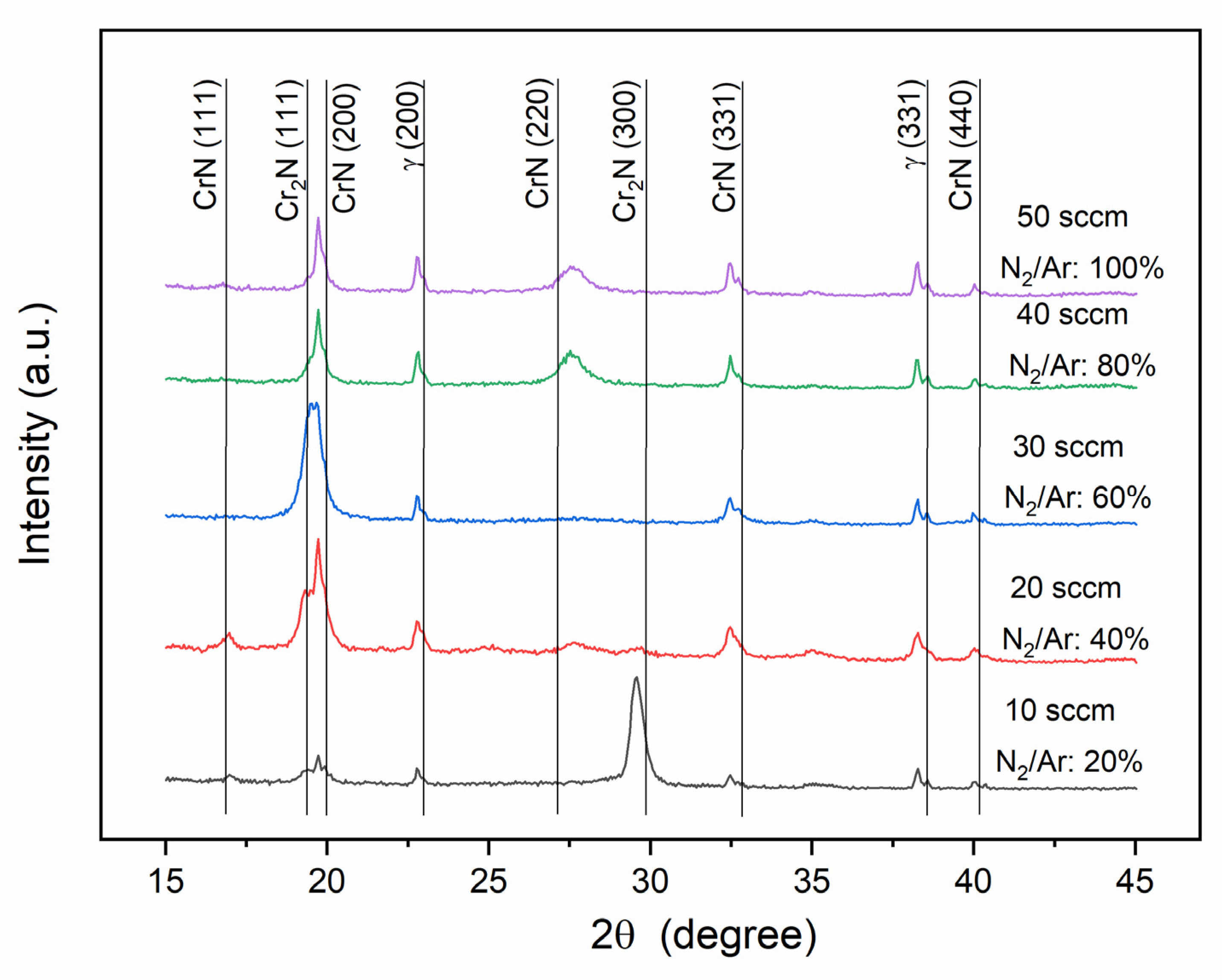

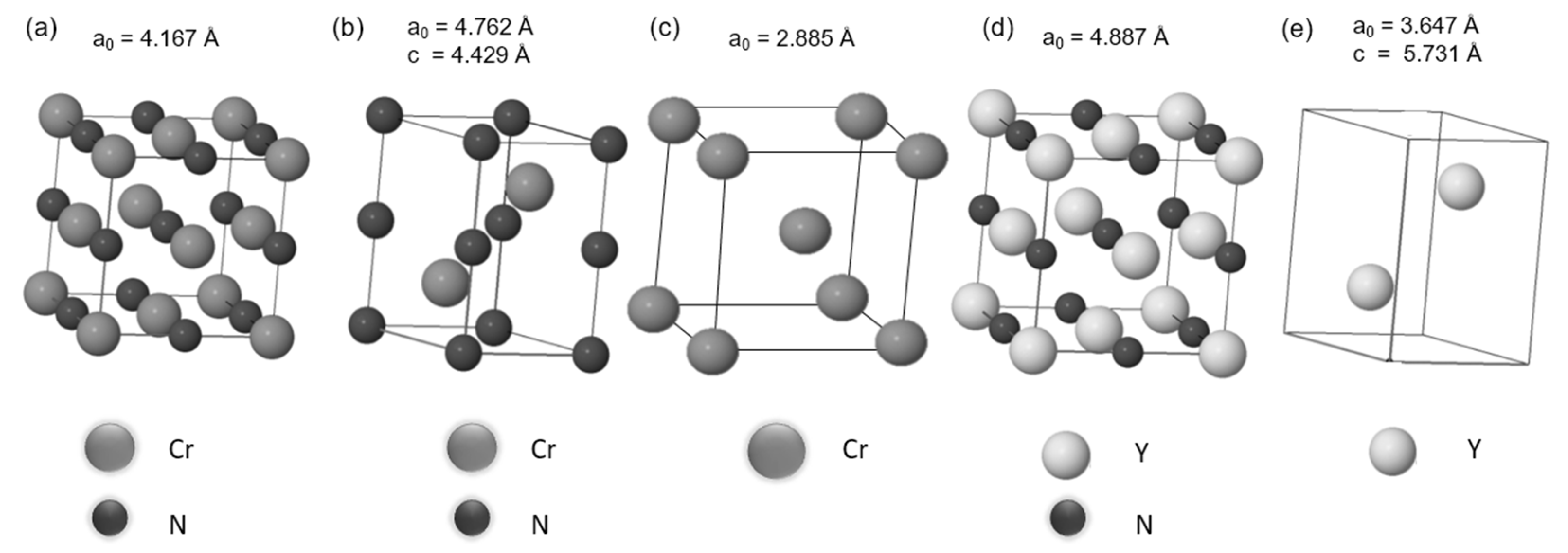

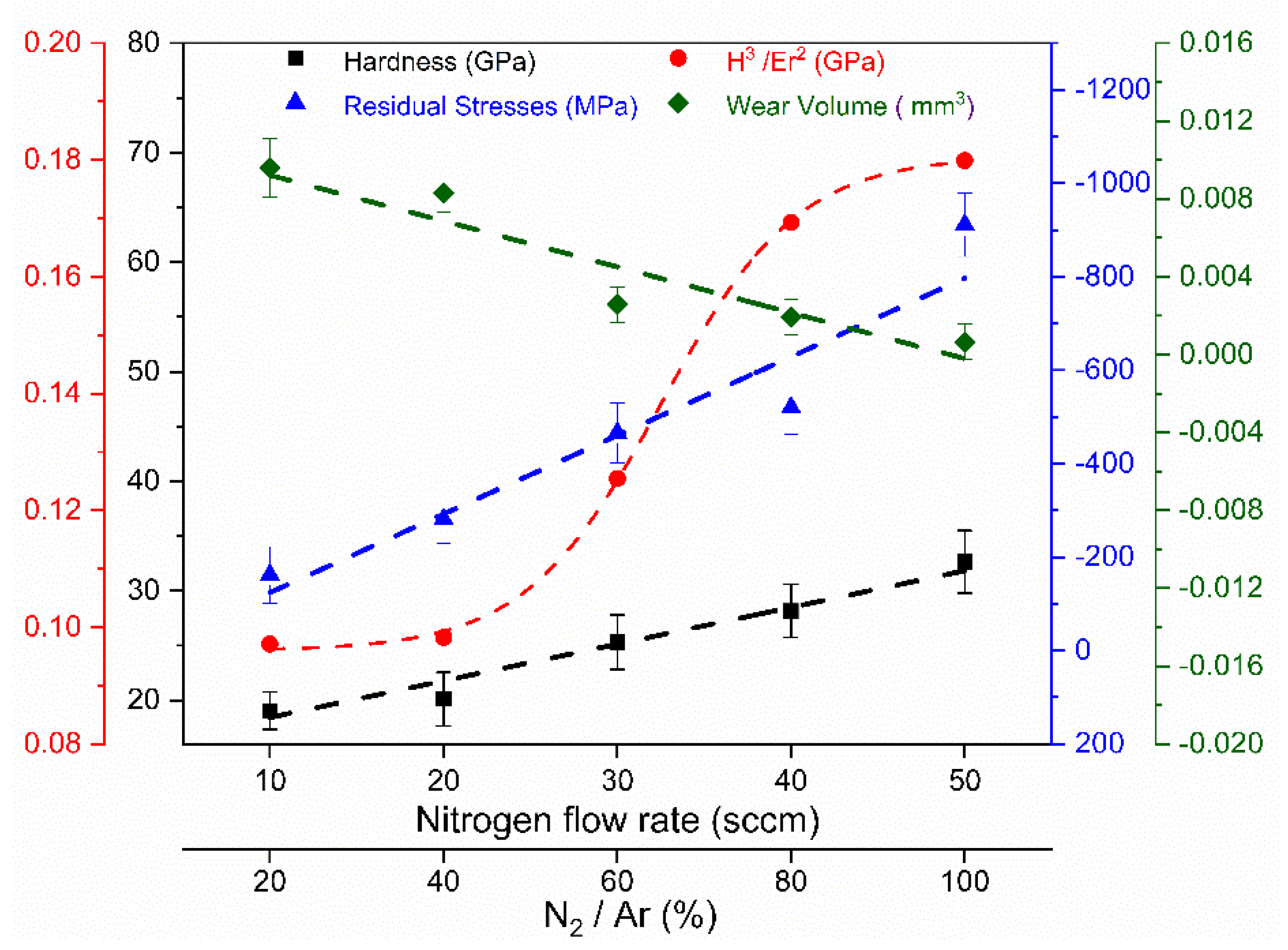


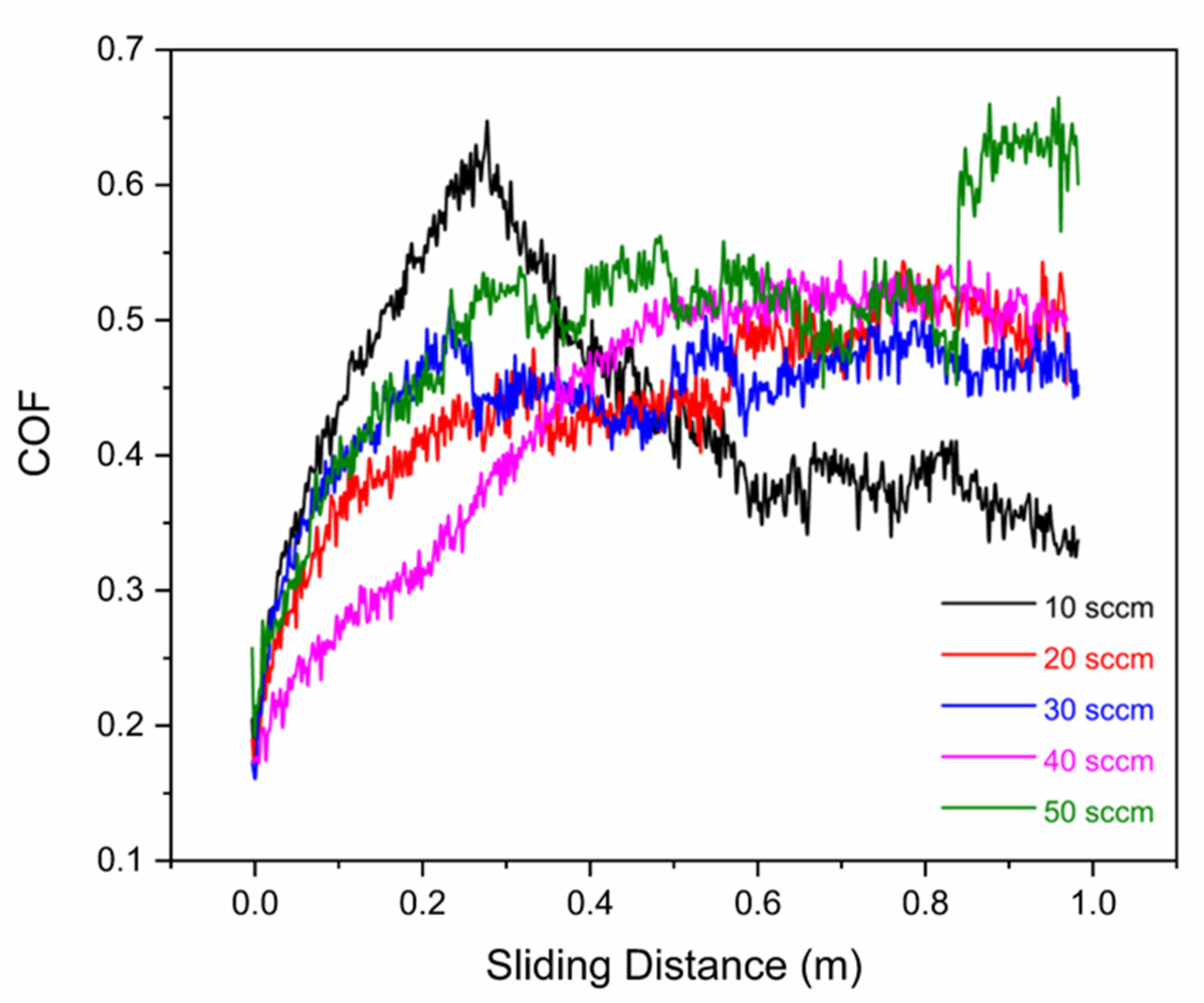
| Nitrogen Flow Rate | Phase | hkl | Domain Size (nm) |
|---|---|---|---|
| 10 sccm | CrN | (111) | 112 ± 1 |
| (200) | 60 ± 1 | ||
| (331) | 73 ± 1 | ||
| (440) | 113 ± 1 | ||
| Cr2N | (111) | 58± 1 | |
| (300) | 72 ± 1 | ||
| 20 sccm | CrN | (111) | 62 ± 1 |
| (200) | 57 ± 1 | ||
| (220) | 53 ± 1 | ||
| (331) | 105 ± 1 | ||
| (440) | 312 ± 2 | ||
| Cr2N | (111) | 57 ± 1 | |
| (300) | 131 ± 1 | ||
| 30 sccm | CrN | (200) | 47 ± 1 |
| (331) | 155 ± 1 | ||
| (440) | 451 ± 2 | ||
| Cr2N | (111) | 50 ± 1 | |
| 40 sccm | CrN | (200) | 71 ± 2 |
| (220) | 57 ± 1 | ||
| (331) | 231 ± 1 | ||
| (440) | 431 ± 2 | ||
| 50 sccm | CrN | (111) | 127 ± 1 |
| (200) | 109 ± 2 | ||
| (220) | 137 ± 1 | ||
| (331) | 104 ± 1 | ||
| (440) | 525 ± 2 |
| Nitrogen Flow Rate (sccm) | μrms | μmáx |
|---|---|---|
| 10 | 0.491 | 0.642 |
| 20 | 0.433 | 0.536 |
| 30 | 0430 | 0.510 |
| 40 | 0.425 | 0.537 |
| 50 | 0.420 | 0.659 |
Publisher’s Note: MDPI stays neutral with regard to jurisdictional claims in published maps and institutional affiliations. |
© 2022 by the authors. Licensee MDPI, Basel, Switzerland. This article is an open access article distributed under the terms and conditions of the Creative Commons Attribution (CC BY) license (https://creativecommons.org/licenses/by/4.0/).
Share and Cite
Apolinario, R.C.; Rodrigues, A.M.; Avila, P.R.T.; Pereira, J.N.; Ramirez, C.A.O.; Daum, P.; Costa, F.P.d.; Lira, H.d.L.; Neves, G.d.A.; Greiner, C.; et al. Role of Nitrogen and Yttrium Contents in Manufacturing (Cr, Y)Nx Film Nanostructures. Nanomaterials 2022, 12, 2410. https://doi.org/10.3390/nano12142410
Apolinario RC, Rodrigues AM, Avila PRT, Pereira JN, Ramirez CAO, Daum P, Costa FPd, Lira HdL, Neves GdA, Greiner C, et al. Role of Nitrogen and Yttrium Contents in Manufacturing (Cr, Y)Nx Film Nanostructures. Nanomaterials. 2022; 12(14):2410. https://doi.org/10.3390/nano12142410
Chicago/Turabian StyleApolinario, Raira Chefer, Alisson Mendes Rodrigues, Pedro Renato Tavares Avila, Júlia Nascimento Pereira, Carlos Alberto Ospina Ramirez, Philipp Daum, Fabiana Pereira da Costa, Hélio de Lucena Lira, Gelmires de Araújo Neves, Christian Greiner, and et al. 2022. "Role of Nitrogen and Yttrium Contents in Manufacturing (Cr, Y)Nx Film Nanostructures" Nanomaterials 12, no. 14: 2410. https://doi.org/10.3390/nano12142410








